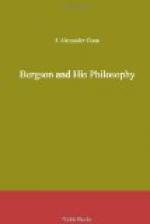A study of the facts shows us three very marked tendencies which may be denoted by the terms “Torpor,” “Instinct,” and “Intelligence.” These are, in a sense “terminal points” in the evolutionary process. Hence arises the distinction of plant and animal, one showing a tendency to unconscious torpor, the other manifesting a tendency towards movement and consciousness. Then again arises another divergence which gives rise to two paths or tendencies, one along the line of the arthropods, at the end of which come the ants and the bees with their instincts, and the other along the line of the vertebrates, at the end of which is man with his intelligence. These three, Torpor, Instinct, and Intelligence, must not, however, be looked upon as three successive stages in the linear development of one tendency, but as three diverging directions of a common activity, which split up as it went on its way. Instinct and Intelligence are the two important terminal points in Evolution. They are not two stages of which one is higher than the other, they are at the end of two different roads. The wonders of Instinct are a commonplace to students of animal and insect life. [Footnote: See the interesting books by the French writer, Henri Fabre.] Men, with their intellect, make tools, while Instinct is tied to its tool. There is a wondrous immediacy, however, about Instinct, in the way it achieves ends, and its operations are often quite unconsciously performed. The insect or animal could not possibly “know” all that was involved in its action. Instinct, then, is one form of adaptation, while Intellect is quite another. In man—the grown man—Intellect is seen at its best. Yet we are not without Instincts; by them we are bound to the race and to the whole animal creation. But in ants and bees and such like creatures, Instinct is the sole guide of life, and it is often a highly organized life. The following example clearly shows the contrast between Instinct and Intelligence. A cat knows how to manage her new-born kittens, how to bring them up and teach them; a human mother does not know how to manage her baby unless she is trained either directly or by her own quick observation of other mothers. A cat performs her simple duties by Instinct, a human mother has to make use of her Intelligence in order to fulfil her very complex duties. We must observe, however, the relative value of Instinct and Intelligence.




